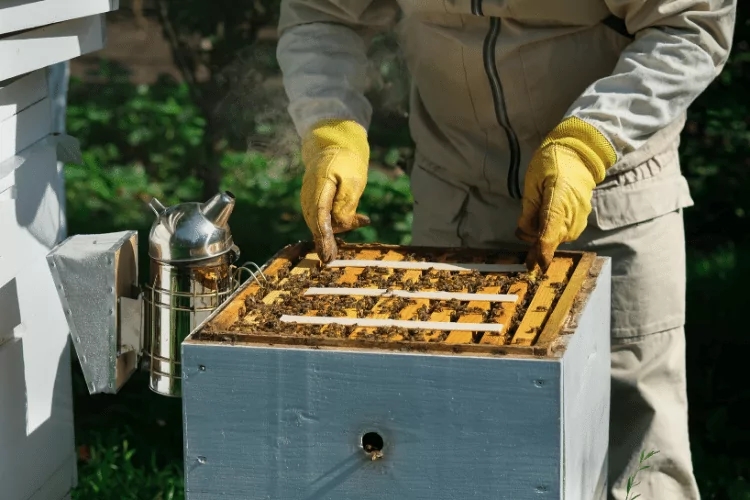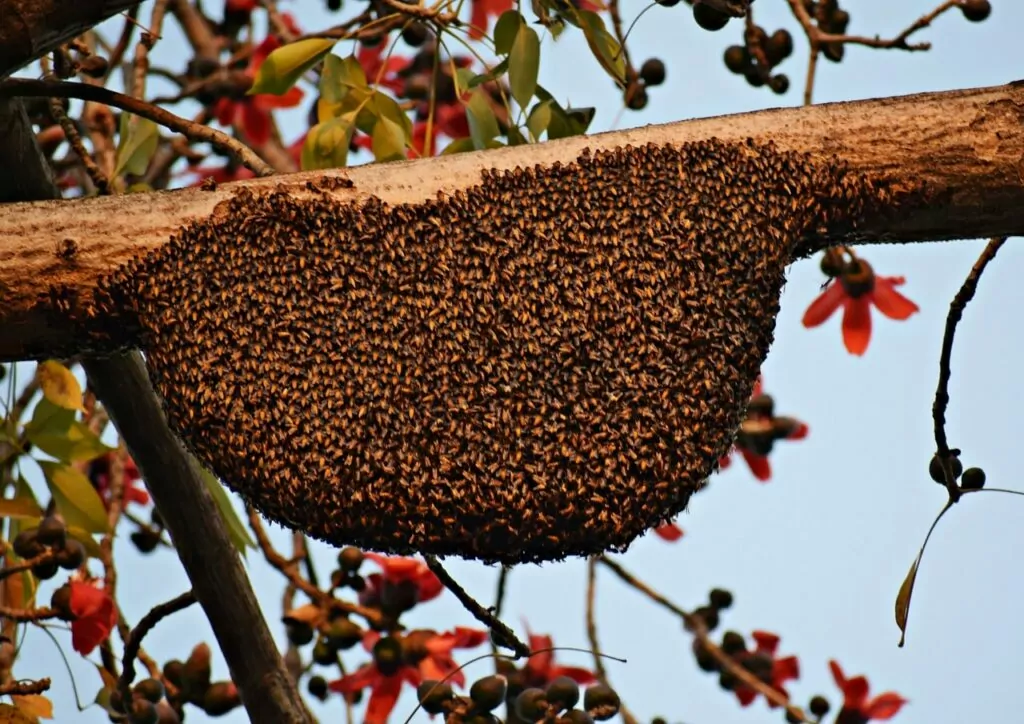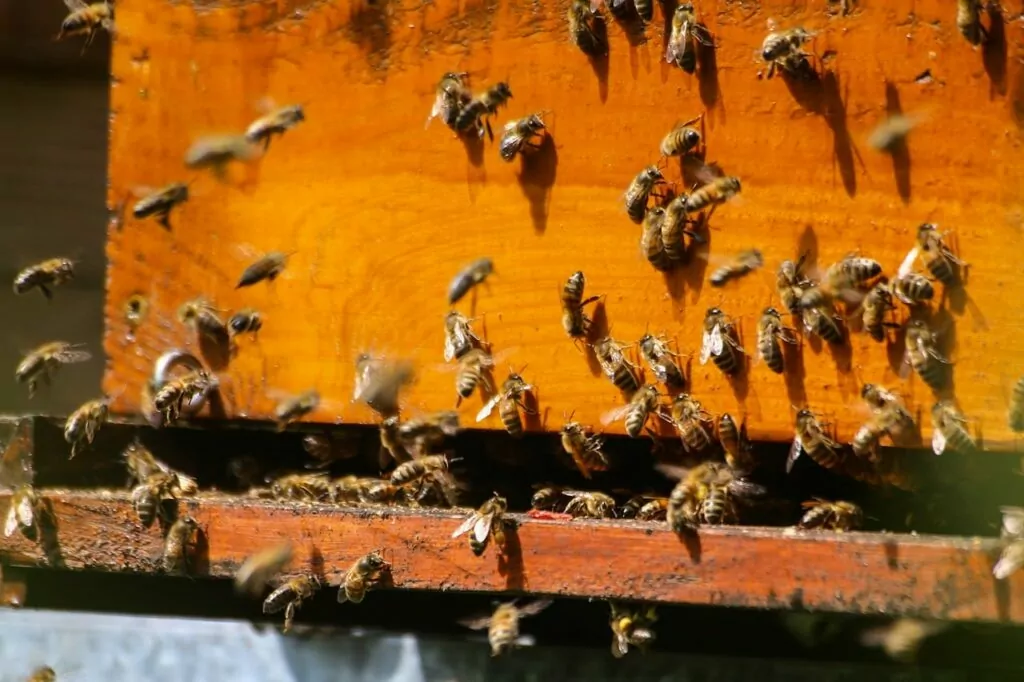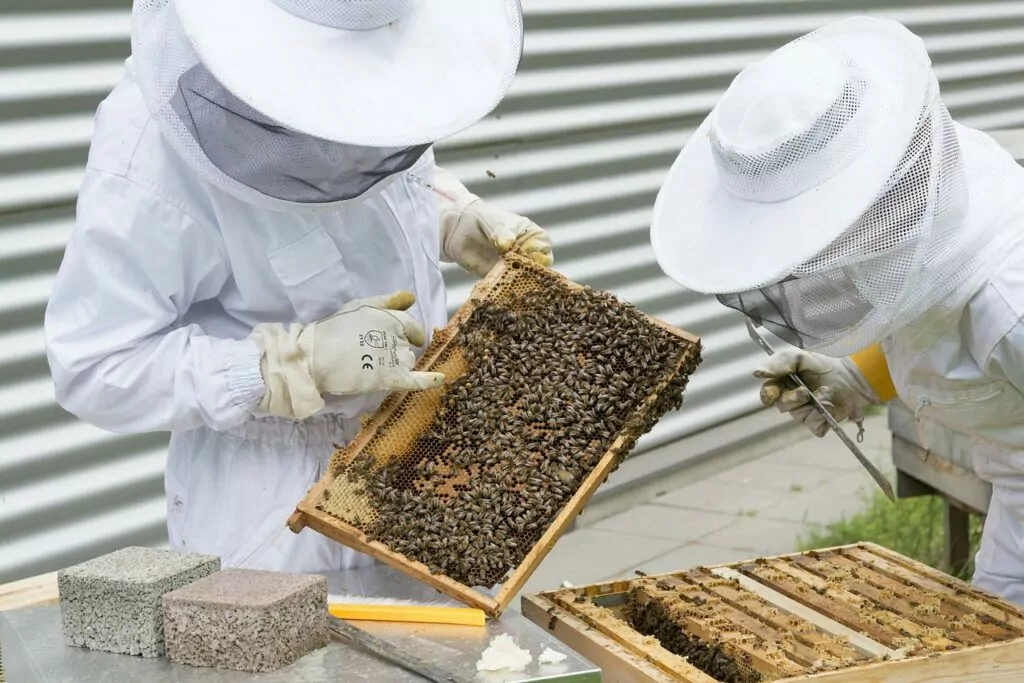Varroa mite infestations are a serious issue that poses a real threat to bees. In fact, if left unchecked, it can lead to colony collapse or hive loss.
On top of that, the mites are so small that you can barely see them with the naked eye. That means the removal process can be a bit of a pain.
Luckily, there are quite a few chemicals on the market that can help you out with mite treatment. You should be able to find a variety of pesticides that can eliminate the infestation.
Two excellent examples of this are Apiguard and Apivar.
So, if you’re wondering about the differences between Apiguard vs. Apivar, you’ve come to the right place.
In this article, we’ll walk you through everything you need to know about these miticides. Plus, we’ll cover all the main differences and similarities between the two.
Varroa Mite Infestations
Over the past few decades, the honey bee population has taken a significant hit. This is mostly due to habitat destruction and climate change.
Although, there’s another major threat that hides away inside the hive. Varroa mites are a type of parasitic insect that feeds on honey bees.
These critters will enter a colony and destroy it from the inside out.
In this section, we’ll discuss the effects of the infestation on the hive. On top of that, we’ll take a look at how to identify Varroa mites.
Effects
To understand the severity of a Varroa infestation, you need to know what these critters can do.
For starters, a single female mite will enter the bee colony. We call her the foundress.
She’ll hop around looking for brood cells. These are special areas in the hive where baby bees develop.
Once a queen lays an egg in a fresh cell, the foundress will jump in to join it. After that, a nurse bee will seal the cell off with a wax capping.
At this point, the baby bee is trapped inside with a mite. That’s when the foundress pierces the larvae’s cuticle and begins feeding on the baby bee.
Soon later, the mite will lay its first egg. Since it’s unfertilized, it’ll develop into a male. A few hours after that, the foundress will lay another egg that hatches a female mite.
This is the start of the infestation. It’ll only take about six or seven days for the baby mites to grow into fully-fledged adults.
Then, once the baby bee in the cell emerges, the mites are free to move around the colony. They’ll attach themselves to the bee and fly all over the hive looking for their next meal.
This process can lead to many deformities in the brood. The baby bee will come out weakened, often with misshapen wings.
Over time, more honey bees will fall prey to the mite infestation. Because of that, adult honey bee workers and drones won’t be able to carry out their jobs.
Without the proper intervention, this can result in colony collapse.
Identification
There are quite a few types of parasites that can infect a honey bee colony. For example, beetles, moths, and of course, mites like to feed on hives.
Sadly, there’s no solution that’ll get rid of all of these pests. So, before you buy a pesticide, you have to pinpoint the unwanted guests in the colony.
Thankfully, there are many tests that can help you identify Varroa mites. The easiest method is the Sugar Roll experiment.
All you need for this process is a jar, fine-sieve mesh, and a little powdered sugar.
Start out by scooping a few handfuls of bees into the jar. Be as gentle as you can during this step.
Next, seal the jar with the fine-sieve mesh. This should let the air flow in while keeping the bees trapped.
After that, sprinkle a few spoonfuls of powdered sugar onto the jar. Make sure that all the bees inside are fully coated in the white powder.
This isn’t harmful to the bees and they can just clean it off later on.
The sugar will cover Varroa mites and affect their ability to stay attached to bees. Because of that, they’ll simply fall off.
Once that’s done, turn the jar upside down and shake it well. Any Varroa mites present should fall through the sieve.
If you see tiny reddish-brown spots falling out, then you have a mite infestation.
Finally, remove the sieve seal and release the bees.

Apiguard Overview
Apiguard is one of the most popular miticides on the market. It’s a slow-release gel matrix that can eliminate a Varroa infestation in a flash.
The main active ingredient in this pesticide is thymol. This is a naturally occurring substance in plants like thyme, mint, and rosemary.
Once thymol evaporates, it can enter the parasitic mites’ systems. It’ll attack the GABA receptors in the tiny critters.
That, in turn, will have many negative effects on their nervous system. Because of that, the mites won’t be able to move for quite a while.
So, they’ll fall off the bees and drop to the bottom of the hive. After a little time, Varroa mites will starve and fade away.
To top it all off, thymol vapors can cause bees to engage in more intense cleaning behavior. They fan out the hive and even remove brood cells.
This will make it much harder for mites to hide out in the colony.
Unfortunately, this can interfere with the bees’ chemical cues. It’ll trigger the same response as when a bee in the colony dies.
Plus, a high thymol concentration can be lethal to bees.
Pros
- Can get rid of a mite infestation rapidly
- Bees engage in more intense cleaning patterns, so the hive is usually spotless
- Less toxic than other pesticides
- Slow-release mechanism allows for the correct concentration to spread through the hive
- Isn’t harmful to bees in the correct concentration
Cons
- Can’t get rid of mites in brood cells
- Some residue can show up in the honey and wax
- Won’t work with honey supers
Apivar Overview
There are many apiarists that prefer to use Apivar. This is a pesticide that comes in the form of plastic polymer strips. It’s easy to use and highly effective, to boot.
The chief component of this product is amitraz. That’s a non-systemic pesticide, which means it can kill mites through contact.
The chemical will stimulate centers in the mites’ brains and inhibit enzyme activity. This will wreak havoc on the insects’ nervous systems.
So, the colony mites won’t be able to move their jaws or limbs. That’ll cause them to detach from the bees and fall to the bottom of the hive.
Because of that, they can’t feed or reproduce, which effectively ends the infestation.
Aside from that, Apivar is usually completely safe for bees. It won’t interfere with the flying critters’ activity.
Plus, amitraz isn’t soluble in honey or beeswax. For that reason, there shouldn’t be any detectable residue in either product.
Although, in high concentrations, Apivar can be damaging to the environment. It may negatively impact harmless insects while attacking the mites.
On top of that, Apivar can’t handle long storage periods. Once you open the sealed package, the pesticide will start to lose effectiveness.
Pros
- One of the most effective pesticides on the market
- Doesn’t affect bee activity inside the hive
- Easy to use, with detailed instructions on the packaging
- Strips come in a few sizes to fit into any beehive shape
- Doesn’t leave a detectable residue in honey or beeswax
Cons
- Mites can develop a resistance to this pesticide
- High concentrations can have a negative impact on the environment
- You may need to contact a vet to get your hands on the pesticide
Apiguard vs. Apivar
At this point, you should have some idea of how each acaricide works. Now, we’re ready to move on to the major differences and similarities.
In this section, we’ll cover some of the most notable features of Apiguard and Apivar. Plus, we’ll go over the distinctions between them.
1. How to Use
Apiguard comes in the form of a gel, while Apivar uses saturated polymer strips. As you can imagine, we’ll use each one a little differently.
With Apiguard, you have to open up the hive. After that, peel back the foil seal on the container.
Be sure to leave one corner of the foil attached to the container. That’ll make removing it later on much easier.
Next, place the Apiguard in a central location on top of brood frames. The gel side should be facing upwards.
Once that’s done, close the hive lid while leaving at least a quarter-inch gap on top of the Apiguard.
You can leave the container in the hive for up to six weeks.
Moving on, using Apivar is much easier. All you have to do is remove the strips from the container and place them in the hive.
Typically, it’s best to place one strip for every five frames of bees. Although, you can use more in brood boxes.
Then, you have to wait about six to eight weeks for the pesticide to take effect.

2. When to Use
While Apiguard and Apivar are safe for bees, neither one is particularly good for humans. So, you need to ensure that none of the pesticides makes its way into honey.
Because of that, many beekeepers only use pesticides after the main honey harvest. That way, they ensure that the honey flow isn’t affected.
This typically occurs sometime during fall. Although, some apiarists collect honey a little later in the year.
Besides that, as the weather gets a little chilly, bees will gather in the hive. That means there will be a lot more movement inside the frames.
This will help the acaricides distribute all over the colony faster.
3. Dosage
Most pesticides contain some form of toxic materials. For that reason, you need to be careful about how much of the chemicals you use.
Otherwise, you may end up hurting the bees in the hive.
With Apiguard, you start out with one gel container in the colony. This should be able to reduce the Varroa mite population greatly.
Then, after two weeks, you have to examine the bee frames. If you still notice many pests, then you can add another container to the hive.
Finally, remove both Apiguard containers within six weeks of the first application. That way, you ensure that thymol levels don’t increase to toxic levels.
Moving on, with Apivar, the dosage is a little more flexible. You only need about two strips per brood box.
This should be able to eradicate any parasitic mites that visit the area.
Using less Apivar will still reduce the Varroa infestation. Although, it’ll take a much longer time. Plus, it’ll increase the number of mites that develop a resistance to the pesticide.
Other than that, you can choose to use more strips, but that may lead to a build-up of residue in honey.
4. Effectiveness
Apivar and Apiguard are both incredibly potent. Although there are some differences in effectiveness.
For starters, Apiguard will work much faster. As soon as you place the pesticide container in the colony, it’ll begin turning into vapor.
Depending on the temperature of the hive, it’ll take two to nine days for the gel to completely dissipate.
During this time, most Varroa mites will die as soon as they come in contact with the vapors. So, within a few days, the pests population will take a significant hit.
Yet, it’s best to wait the full six weeks of the treatment process. That way, you ensure that there are no mites hiding out in brood cells.
Apivar, on the other hand, takes a little more time to work. It’ll need about four to five days for the concentration of amitraz to build up in the hive.
After that, Varroa mites will start dying off. Plus, it can take up to eight weeks for this acaricide to eradicate the pests.
5. Shelf Life
When getting rid of pests, you need to ensure that you kill every last Varroa mite. Otherwise, the entire infestation cycle can start all over.
Because of that, most apiarists will buy a little more pesticide than they think they need. Although, not all acaricides have extended shelf lives.
So, before you stock up, it’s a good idea to check how long these chemicals last.
Luckily, you can store Apiguard for an exceptionally extensive period. On average, this miticide can last for about three years.
Plus, if you wrap the containers in foil and freeze them, they can stay fresh for over six years.
Moving on, Apivar has a much shorter shelf life. As soon as you open the packaging, it’ll only be useful for around a year or two.
After that, the pesticide will lose most of its potency. Even freezing the chemical can’t stop it from degrading over time.
6. Operating Temperature
When picking out a miticide, you have to take ambient weather into account. That’s because some chemicals are highly sensitive to temperature.
For instance, Apiguard will work optimally at around 68℉ to 77℉. This range provides the ideal heat levels for the gel to turn into vapor.
Although, the acaricide can function in temperatures as low as 54℉. Anything below that and the thymol won’t be able to evaporate.
As for Apivar, it’s much less sensitive to temperature fluctuations. In fact, you should be able to use this chemical no matter how warm the beehive is.
So, if you live in a particularly cold or hot area, Apivar is the way to go.
7. Effect on Bees
If you’re worried about bee safety, then Apivar is the best pesticide to use. That’s because this chemical should have no effect on the flying critters.
Even with prolonged exposure, bees don’t seem to show any adverse effects.
However, Apiguard is a different story. While it won’t harm the bees physically, it can impair their ability to communicate with each other.
Plus, it can cause them to aggressively clean the hive, which may damage baby broods in the process.
Finally, a high concentration of thymol may prove lethal to adult bees.
8. Exposure and Residue
When choosing a pesticide, an apiarist will ensure that the chemical is harmless to bees. Yet, they’ll forget to check if it’s safe for human consumption.
With Apivar, you don’t have to worry since it’s non-toxic to humans. On top of that, this miticide doesn’t leave much residue in honey.
Still, even if some Apivar makes it into the sweet treat, it should be safe to eat.
However, Apiguard is a little more dangerous. It can cause minor skin irritation or legions. For that reason, it’s crucial that you wear gloves when handling this pesticide.

Besides that, ingesting thymol may result in burning pain in the esophagus and nausea. So, the overuse of Apiguard can significantly reduce the quality of your honey.
9. Stability
Both thymol and amitraz are volatile chemicals. That means they can evaporate quickly. Although, the form these pesticides take can affect their stability.
For instance, Apiguard comes as a gel matrix. This allows the thymol to vaporize slowly, which will increase its effectiveness.
As for Apivar, the polymer strips don’t provide a lot of grip. That means once you open the packaging, amitraz will begin evaporating quickly.
Overall, that means Apiguard is much more stable than Apivar.
10. Mite Resistance
Mites can develop a resistance to almost any pesticide. This happens due to mutations in the pest population.
To help you understand this, let’s take a look at how resistant mites come about.
After a few days of adding Apivar to a colony, the pests will drop to the bottom of the hive. They’ll spend a couple of hours in agony, unable to feed.
At this point, most of the Varroa mites will begin to die off. Although, a few tough critters will be able to fight off the chemical and get back up.
If these bugs manage to reproduce, they’ll pass on resistance to their offspring.
So, after a few new generations of mites hatch, Apivar will no longer be effective. The only way around this issue is to use another pesticide.
You’ll need to cut off Apivar for a few seasons before you can use it again.
Fortunately, this isn’t the case with Apiguard. Even with extended use, almost no colony mites show any resistance to the chemical.
Plus, it’s important to note that only Apiguard can get rid of tracheal mites. These are phoretic mites that hide away in bee airways, far out of Apivar’s reach.
11. Environmental Impact
When using a pesticide, you should be aware of the effect it’ll have on the environment. That way, you’ll ensure that all the creatures around the hive are safe.
With Apiguard, there’s no cause for concern. This miticide is quite stable and isn’t likely to seep into the surrounding area.
Yet, Apivar is much more volatile. That means some of the amitraz can make its way outside easily.
If that happens, the living creatures around the hive may face some side effects. The chemical can cause problems with respiration and reproduction.
On top of that, it may result in skin irritations.
12. Packaging
Apivar strips come in a sleek sealed plastic bag. This ensures that none of the amitraz can leak out before you’re ready to use it.
On top of that, Apivar containers are incredibly easy to store. The packaging is exceptionally thin, so you can pack it away almost anywhere.
As for Apiguard, the packaging is a bit bulkier. The gel capsules come in a cardboard box. That means you’ll have to clear out a space on your shelf to store it away.
13. Cost
When it comes to cost, Apiguard is slightly more expensive. Although, this will depend on your location and the manufacturer.
Yet, since Apiguard lasts for a long time, you can buy it in bulk. That means you should be able to find a good deal on this pesticide.
Wrapping Up
If you’re comparing Apiguard vs. Apivar, there are a few factors to consider. These include the dosage, shelf life, and operating temperatures.
Yet, before you do that, you need to ensure that your hive is battling a Varroa mite infestation. Otherwise, you risk harming the bees.
When it comes to effectiveness, both pesticides are potent. Although, Apiguard is a little more fast-acting.
Moving on, Apivar is much less sensitive to temperature fluctuations. That means you can use it in both warm and cold climates.
Finally, mites are less likely to develop a resistance to Apiguard. Plus, this acaricide can get rid of tracheal mites.





